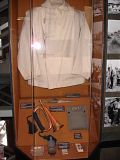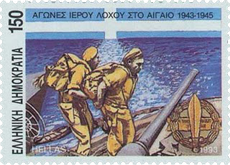In 1942, there appeared to be disproportionately many officers in the Greek army fighting in the Middle East. To address this issue, a special foces unit was formed that was composed entirely of officers and officer cadets. In reality, many of the "officers" were simple soldiers who had fled to Turkey and had been told (presumably erroneously) that they couldn't join the army in North Africa unless they were officers.
The unit, initially named "Company of Chosen Immortals" was formed under Cavalry Major Antonios Stefanakis in Palestine, with 200 men, 130 of which were officers. It was organised as a Machine Gun Company and intended to be attached to the II Greek Brigade. This changed when its new commander Col. Christodoulos Tsigantes took over. Tsigantes was an ex-Venizelist, who had taken part in the attempted coup of 1935. His first move was to get rid of those who were openly leftist and any others he considered troublemakers. Using his close relations with officers in the Allied HQ, he applied and succeeded in converting the unit into a special forces unit, which he renamed "Sacred Band".
After intensive training in the British SAS camp in Cairo and additional training in Palestine, the Sacred Band was placed in battle in El Alamein and Tunisia. By then it numbered 400 men. Until August 1945, when it was disbanded, it fought alongside the SAS in the Libyan desert and the Aegean, as well as with General Leclerc's Free French Forces in Tunisia. The Sacred Band of 1942-45 is the precursor of the modern Greek Special Forces and some of its traditions are carried on by the Mountain Raiding Companies (LOK), founded in 1946.
Operational History
1942 - In close cooperation with the commander of the British SAS Regiment, Lt. Colonel David Stirling, and with the approval of the Greek HQ, the company moved to the SAS base at Qabrit in Egypt to begin its training in its new role.
17 Nov. 1942 - 27 Jan. 1943 - 8 men under G. Alexandris operate with the SAS behind German lines in Cyrenaica.
4 Dec. 1942 - 60 men move towards Benghazi to perform SAS-like sabotage raids, but the mission is cancelled due to the rapid advances of the British.
27 Jan. 1943 - Following special training, the Sacred Band moves west to join the SAS in raids behind German-Italian lines. The mission is cancelled due to recent heavy losses of the SAS and the capture of its leader, Stirling.
7 Feb. 1943 - Following Colonel Tsigantes's suggestion, General Montgomery puts the Sacred Band under the command of General Leclerc of the Free French 2nd Armoured Division, with the duties of Light Mechanised Cavalry.
10 Mar. 1943 - In Ksar-Rillan, Tunisia, the Sacred Band gives its first battle against a German mechanised detachment, while covering the advance of the X British Army Corps that try to by-pass the Mareth defence line from the South.
29 Mar. 1943 - After the Allied forces capture Gabès, Tunisia, the Sacred Company is detailed to the 2nd New Zealand Division
6 Apr. 1943 - A mixed Greek-New Zealand detachment fights against the Germans at Wadi Akarit.
12 Apr. 1943 - The Sacred Band enters Sousse, and participates in the battle for Enfidaville between April 13 and 17.
May 1943 - The Sacred Band, now composed of 314 men, moves to Palestine, in various camps.
July 1943 - It takes parachute training in Jenin and undergoes a reorganisation into an HQ Section, a Base Section, and Commando Sections I,II and III.
9 Sep. 1943 - The Italians capitulate and British forces start moving into the Italian-occupied Dodecanese islands.
1-17 Nov. 1943 - Section I of the Sacred Band is dropped by air to the Greek island of
Samos, while sections II and III move there on fishing boats. With the failure of the campaign after the battle of Leros, however, Samos is evacuated, and the men of the Sacred Band withdraw to the Middle East.
Feb. 1944 - Put under the command of the British Raiding Forces.
7 Feb. 1944 - Section I moves for combat operations to the islands of the northern Aegean sea, while Section II moves to the Dodecanese with the same purpose.
29 Mar. 1944 - The Sacred Band liberates the island of Psara.
3 Apr. 1944 - 30 men perform diversionary attack in Mitilini.
Apr. 1944 - The Sacred Band attacks Ios, Paros and Amorgos. It also expands to regimental size, with a strength of around 1,000 men. This reflects the unit's effectiveness, and, from a British standpoint, political reliability in the face of mounting political tensions among the Greek forces in exile.
17 May 1944 - 31 men raid Samos and destroy selected targets
13-14 Jul. 1944 - A combined Greek-British force neutralises the 200-strong garrison of Simi and captures the island.
Sep. 1944 - Following sabotage raids in Thira, Ko and Karpathos, the Sacred Band with 25 men liberates Mykonos after neutralising its garrison (24-25 Sep.). A little later, it accepts the surrender of the Germans in Lesbos.
 Oct. 1944 - The Greek mainland is liberated and the Sacred Band returns to Greece, where strains are becoming evident in the relationship of Papandreou's British-backed national unity government and the leftist National Liberation Front (EAM), which controls most of the countryside. The crucial issue is the disarmament of the guerrilla forces and the formation of a new national army out of members of both the exiled armed forces and the guerrillas of ELAS and EDES.
Oct. 1944 - The Greek mainland is liberated and the Sacred Band returns to Greece, where strains are becoming evident in the relationship of Papandreou's British-backed national unity government and the leftist National Liberation Front (EAM), which controls most of the countryside. The crucial issue is the disarmament of the guerrilla forces and the formation of a new national army out of members of both the exiled armed forces and the guerrillas of ELAS and EDES. However, the Papandreou government wish to retain the Sacred Band and the 3rd Greek Rimini Mountain Brigade intact. Disbanding them would mean that their members would become individual recruits in a possibly EAM-dominated people's army. This tension eventually spills over into the Dekemvriana events in Athens, where the Sacred Band fights against the Communist ELAS forces.
In the meantime, elements of the Sacred Band escort Papandreou's government in its return to Athens, and parade in front of the people of Athens.
11 Feb. 1944 - 114 men liberate the island of Nisiros.
25 Feb. 1945 - With the help of an Indian company, it neutralises the 200-strong German garrison of Tilos and re-captures the island.
28 Feb. 1944 - 513 men attack and liberate Tinos.
25 Oct. 1944 - 50 men raid Tilos and liberate temporarily the island. The island is re-captured by the Germans a little later.
Mar.-May 1945 - The unit patrols the Dodecanese in armed fishing boats (kaikia), raids Alimia and and participates in the siege of Rhodes. 217 men operate during the night and neutralise all German coastal garrisons of Rhodes. The Germans surrender in Kos and Rhodes.
3-4 May 1945 - Last raid is against the island of Milos.
June 1945 - The unit returns to Egypt.
7 Aug. 1945 - The unit disbands in a ceremony in Athens. During the ceremony the unit's flag is awarded with Greece's highest military awards, the Gold Cross of Valour and the War Cross First Class. The unit's casualties throughout its existence have amounted to 25 dead, 56 wounded, 3 missing and 29 taken prisoner.



Δεν υπάρχουν σχόλια:
Δημοσίευση σχολίου